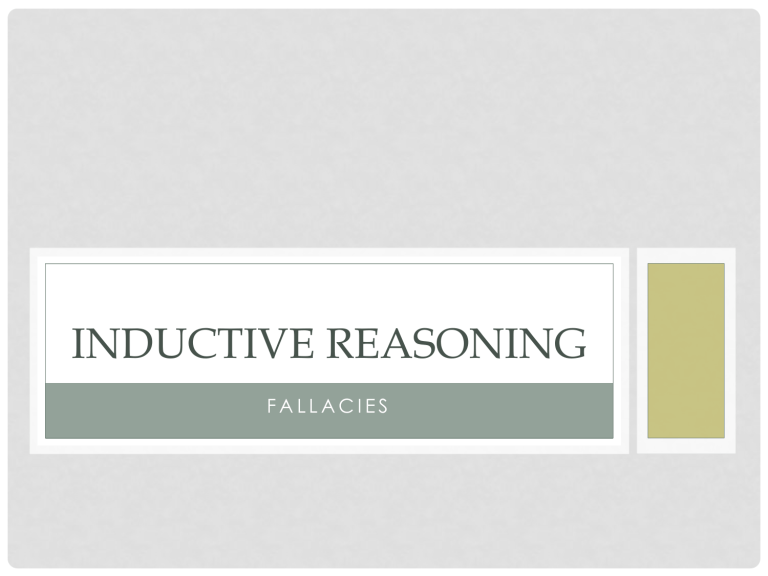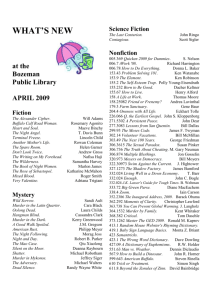Inductive Fallacies

INDUCTIVE REASONING
F A L L A C I E S
INDUCTIVE LOGIC
• No proof or validity
• Best that can be said is that the argument is sound or cogent
• Acceptable by a reasonable person
• Based on our natural ability to think in analogy, metaphor, simile, rhyme, etc.
ARGUMENT FROM DESIGN
• The universe exhibits a structural design (premise)
• A machine exhibits a structural design (premise)
• A machine is made by an intelligent being
(premise)
• The universe was made by an intelligent being
(conclusion)
ARGUMENT FROM DESIGN CON’T
• Analogy drawn between universe and machine
• Form of argument is as follows:
• A has the property of C.
• B has the property of C.
• B has the property of D.
• A has the property of D
EXAMPLE
• We are called to the scene of a murder committed on Tuesday at midnight around Sunset Avenue.
• The murder weapon was a .45, the victim was a derelict alcoholic, and there were a dozen witnesses who saw Jack do it.
• We put out an all-points bulletin on Jack, but he is not apprehended.
EXAMPLE CON’T
• Now suppose that on Wednesday night we are called to the scene of another murder, again committed at midnight on Sunset Avenue.
• The victim is a derelict alcoholic, the murder weapon is a .45, but unfortunately there are no witnesses.
EXAMPLE CON’T
• Tuesday's murder was committed at midnight (T has the property of M)
• Wednesday's murder was committed at midnight (W has the property of M)
• Tuesday's murder took place on Sunset Avenue (T has the property of S)
• Wednesday's murder took place on Sunset Avenue (W has the property of S)
• Tuesday's murder involved a .45 (T has the property of F)
• Wednesday's murder involved a .45 (W has the property of F)
• Tuesday's murder victim was a derelict alcoholic (T has the property of D)
• Wednesday's murder victim was a derelict alcoholic (W has the property of D)
• Tuesday's murder was committed by Jack (T has the property of J)
• Wednesday's murder was committed by Jack (W has the property of J)
FALLACIES
• Hasty Generalization
• Reasoning to an unwarranted generalization on too small of a sample.
• Are 4 similarities enough to warrant a 5 th ?
• Not all similarities are alike
• If you have one strong similarity, are the others weak, or stretched just to find more?
FALLACIES
• Post Hoc, Ergo Propter Hoc (after this, therefore because of this)
• Can you reason that because B followed A that A is the cause of B?
• Usually occurs when you are “dead sure”, or suspect is included in first premise
• The clincher should be the last premise in your thinking
FALLACIES
• Emotional Reasoning
• Words used to persuade?
• “Derelict” in example
• Remain impartial in reasoning!
FALLACIES
• Fallacy of Composition
• Inferring that a property of the parts must also be a property of the whole.
• we did not have any witnesses to the murder on Wednesday night.
• If we were to conclude that Jack likes to leave witnesses around whenever he murders somebody, we would be making this fallacy, or reading more into the whole than the parts imply.
FALLACIES
• False Dilemma
• Assuming there are only two alternatives, X and Y.
• Occurs when premises are weak
• Exists when you must choose between two undesirable alternatives
• Is there a Z factor (third alternative)?
FALLACIES
•
• Affirming the Consequent
• Bottom-up reasoning needs to have hypothesis-testing
• Treat conclusion as a hypothesis, and go back to premises to seek dissimilarities, flaws, or differences that would disconfirm the conclusion
• The obvious flaw is that we have no witnesses to Wednesday's murder, so if we added the logic:
• Tuesday's murder was committed in front of witnesses (If P, then Q)
• Wednesday's murder was not committed in front of witnesses (Q)
• Nevertheless, Tuesday's murder and Wednesday's murder are similar (P)
• We would be affirming the consequent in this case of inductive logic. It is important to try and go back and disconfirm the hypothesis in good faith.





